Deutz TCD 2013 2V Service Manual

Workshop Manual
competence level 3
TCD 2013 2V
|
|
|
|
|
|
|
|
|
|
|
|
|
|
|
|
|
|
|
|
|
|
|
|
|
t |
|
|
|
|
|
|
|
|
|
|
|
|
|
|
|
|
|
|
|
|
|
|
|
|
o |
|
|
|
|
|
|
|
|
|
|
|
|
|
|
|
|
|
|
|
|
|
|
|
|
|
n |
|
|
|
|
|
|
|
|
|
|
|
|
|
|
|
|
|
|
|
|
|
|
|
|
rm |
is |
|
|
|
|
|
|
|
|
|
|
|
|
|
|
|
|
|
|
|
. |
|
|
|
|
|
||
|
|
|
|
|
|
|
|
|
|
|
|
|
|
|
|
|
|
|
|
ic |
fo |
|
|
||
|
|
|
|
|
|
|
|
|
|
|
|
|
|
|
|
|
d |
t |
|
|
|
||||
|
|
|
|
|
|
|
|
|
|
|
|
|
|
protecte |
|
elec |
|
|
|
|
|||||
|
|
|
|
|
|
|
|
|
|
|
|
|
|
|
|
|
|
|
|
n |
|
|
|
||
|
|
|
|
|
|
|
|
|
|
|
|
|
|
|
|
|
|
|
|
tro |
|
|
|
|
|
|
|
|
|
|
|
|
|
|
|
|
|
|
|
|
|
|
agreemen |
. |
|
|
|
||||
|
|
|
|
|
|
|
|
c |
|
|
|
|
|
|
ted |
|
|
|
|
|
|||||
|
|
|
|
|
|
|
|
|
opyright |
|
|
o |
|
|
|
|
|
|
|
||||||
|
|
|
|
|
|
|
|
|
|
|
|
|
|
|
|
|
|
|
|
|
|
|
|
||
|
|
|
|
n |
is |
|
|
her |
prin |
|
|
|
|
|
|
|
|
|
|
||||||
|
|
|
|
|
|
|
|
|
|
prior |
|
|
|
|
|
|
|
|
|
||||||
|
|
|
|
|
t |
|
|
|
|
|
o |
|
|
|
|
|
|
|
|
|
|
|
|
||
|
|
|
cume |
|
|
|
|
it |
|
|
|
|
|
|
|
|
|
|
|
|
|||||
|
|
o |
|
|
|
n |
in |
e |
t |
ur |
|
|
|
|
|
|
|
|
|
|
|
||||
|
d |
|
|
|
|
|
ou |
|
|
|
|
|
|
|
|
|
|
|
|
|
|
||||
s |
|
|
|
|
o |
|
|
|
|
|
|
|
|
|
|
|
|
|
|
|
|||||
Thi |
|
|
|
|
uti |
|
|
h |
|
|
|
|
|
|
|
|
|
|
|
|
|
|
|
||
|
Distrib |
|
wit |
|
|
|
|
|
|
|
|
|
|
|
|
|
|
|
|
||||||
|
|
|
d |
|
|
|
|
|
|
|
|
|
|
|
|
|
|
|
|
|
|
||||
|
|
|
|
we |
|
|
|
|
|
|
|
|
|
|
|
|
|
|
|
|
|
|
|
||
|
|
|
|
llo |
|
|
|
|
|
|
|
|
|
|
|
|
|
|
|
|
|
|
|
|
|
|
|
|
|
a |
|
|
|
|
|
|
|
|
|
|
|
|
|
|
|
|
|
|
|
|
|
0312 2916 en
This document is subject to changes which may become necessary in the course of further development of the engines. Reprinting and reproductions of any kind, even in part, require our written permission.

Regarding copyright questions and licensing agreements
please contact : |
VE-FI, Mr. Sonntag |
|
Phone.: + 49 (0) 221 822-3053 |
|
E-Mail: sonntag.j@deutz.com |
|
DEUTZ AG |
|
Service Information Systems |
|
Ottostraße 1 |
|
D-51149 Köln (Cologne) |
|
Phone.: +49 (0) 221-822-0 |
|
Fax: +49 (0) 221-822-3525 |
|
Internet: www.deutz.com |
|
E-Mail: info@deutz.com |
|
Printed in Germany |
|
All rights reserved |
The engine company. |
1st Edition © 02/2010 |
Order No. 0312 2916 en |

Workshop Manual
TCD 2013 2V
0312 2916 en
This document is subject to changes which may become necessary in the course of further de- velopment of the engines. Reprinting and reproductions of any kind, even in part, require our written permission.

DEUTZ engines |
Table of contents |
1Foreword
2General
3User notes
3.1General
3.2Specifications
3.3Operating manual and workshop manual
3.4Job cards
3.5Explanation of symbols
4Technical data
4.1Testing and setting data
4.2Tightening specifications
5Job card overview
5.1Sorted alphabetically
5.2Sorted numerically
6Job cards
7Commercial tools
8Special tools
© 02/2010 |
1/2 |
OBJ_DOKU-21737-001.fm |
|

Table of contents |
DEUTZ engines |
© 02/2010 |
2/2 |
OBJ_DOKU-21737-001.fm |
|
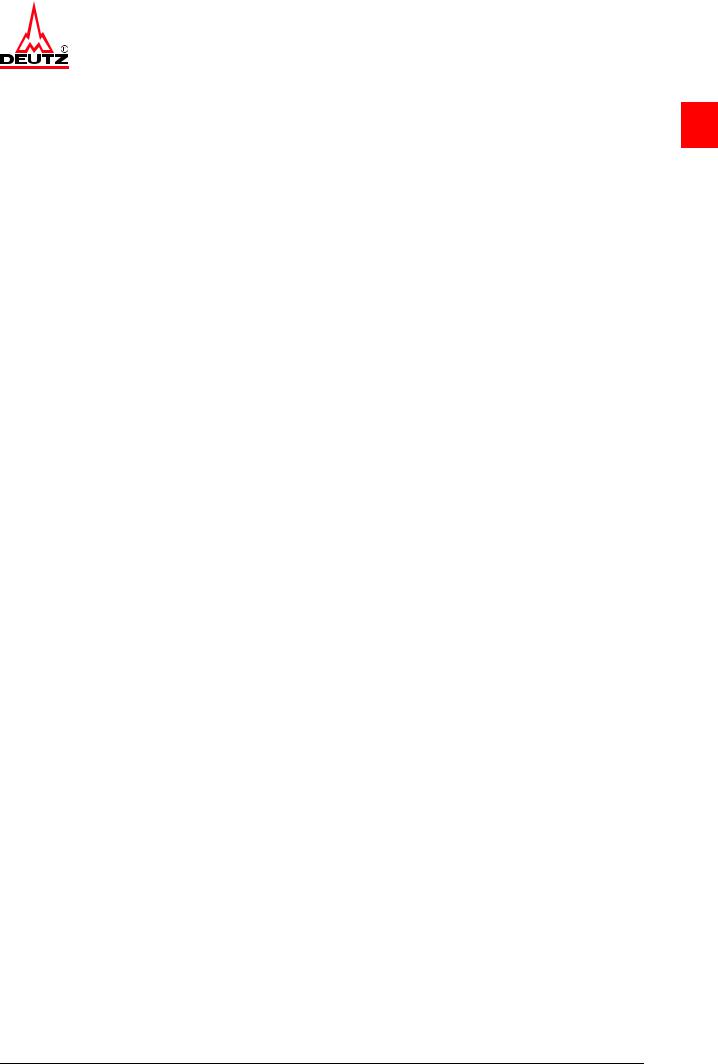
DEUTZ engines |
Foreword |
1
1Foreword
© 05/2005 |
1/4 |
OBJ_DOKU-21738-001.fm |
|
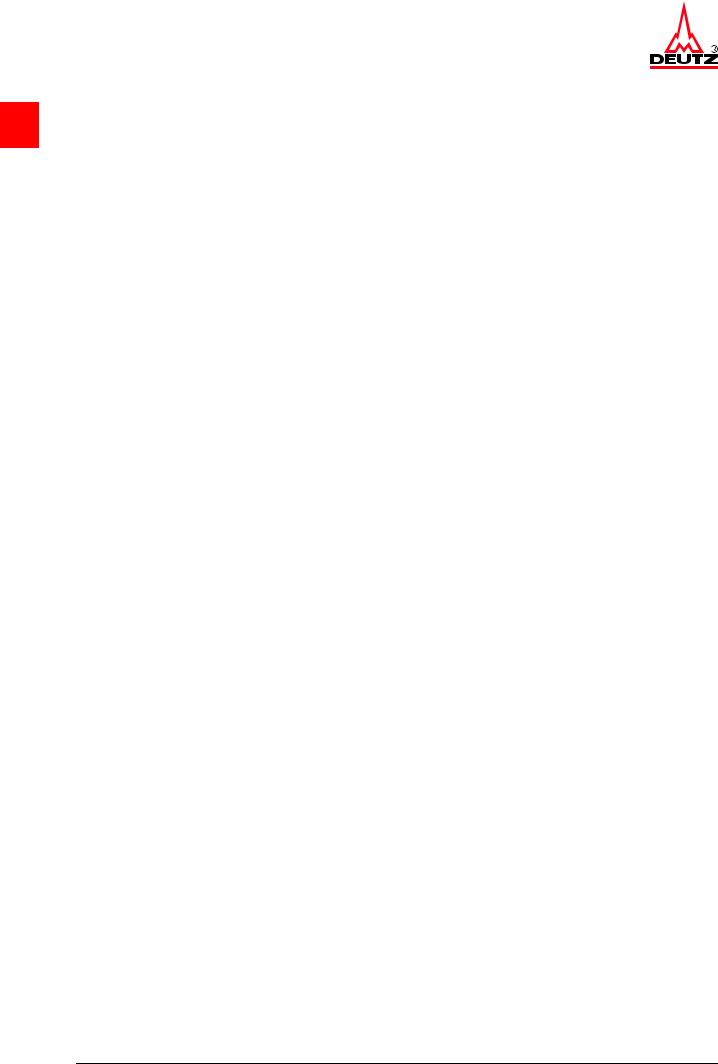
Foreword |
DEUTZ engines |
1
© 05/2005 |
2/4 |
OBJ_DOKU-21738-001.fm |
|
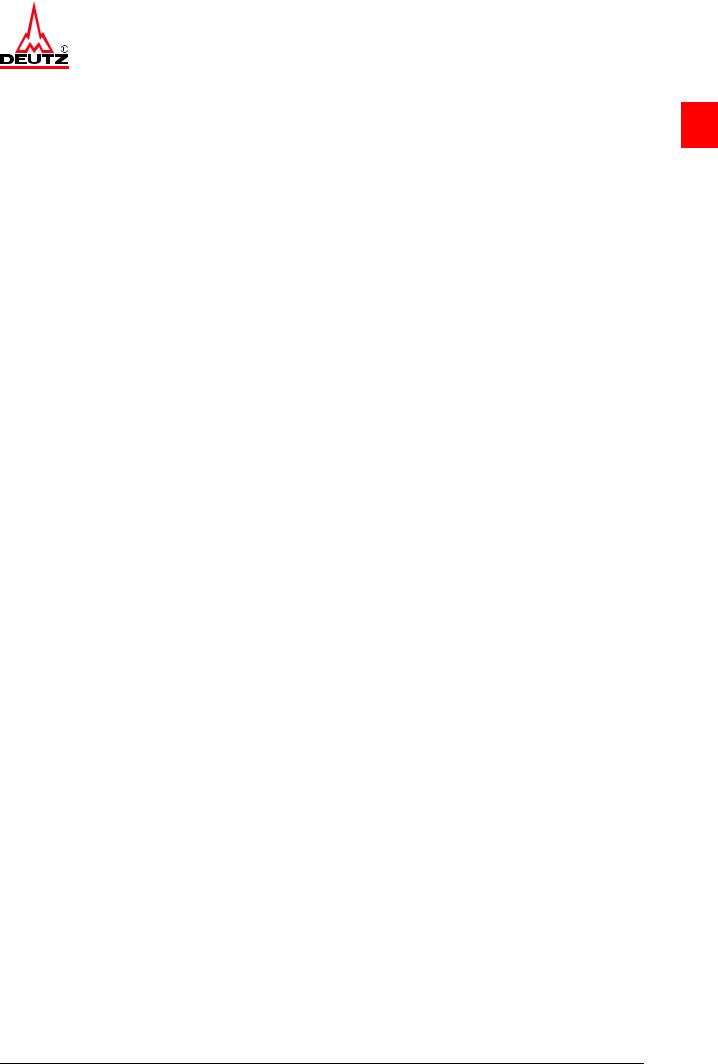
DEUTZ engines |
Foreword |
●Read and observe the information in this docu- mentation. You will avoid accidents, retain the manufacturer's warranty and possess a fully functional and ready to operate engine.
●This engine is built exclusively for purpose ac- cording to the scope of delivery - defined by the equipment manufacturer (use for the intended purpose). Any use above and beyond this is con- sidered improper use. The manufacturer will not be liable for damages resulting from this. The user bears the sole risk.
●Use for the intended purpose also includes ob- servance of the operating, maintenance and re- pair instructions specified by the manufacturer. The engine may only be used, maintained and repaired by persons who are familiar with this and are aware of the risks involved.
●Makesurethatthisdocumentationis availableto everyoneinvolvedintheoperation,maintenance and repair and that they have understood the contents.
●Failure to observe this documentation may lead tomalfunctions and enginedamageaswellasin- jury to persons for which the manufacturer will not accept any liability.
●Prerequisiteforpropermaintenanceandrepairis the availability of all the necessary equipment, conventional and special tools and their perfect condition.
●Engine parts such as springs, clamps, elastic re- taining rings etc. pose an increased risk of injury when handled incorrectly.
●The pertinent rules for the prevention of acci- dents and other generally recognised health and safety regulations must be observed.
●Maximumeconomy,reliabilityandlonglifeisonly guaranteed when using DEUTZ original parts.
● Repair of the engine must correspond to its use |
1 |
for the intended purpose. Only parts released by |
|
themanufacturerfortherespectivepurposemay |
|
be used for conversion work. Unauthorised mod- ifications to the engine exclude manufacturer lia- bility for resulting damages. Failure to observe this will void the warranty!
●The engines made by DEUTZ are developed for a wide range of applications. A wide range of var- iants ensures that the respective special require- ments are met.
●The engine is equipped according to the installa- tion case, i.e. not all the parts and components described in this documentation are installed in your engine necessarily.
●We have done our best to highlight the differenc- essothatyoucaneasilyfindtheoperating,main- tenance and repair instructions relevant to your engine.
We are at your service for any questions you may have in this matter.
Your DEUTZ AG
© 05/2005 |
3/4 |
OBJ_DOKU-21738-001.fm |
|
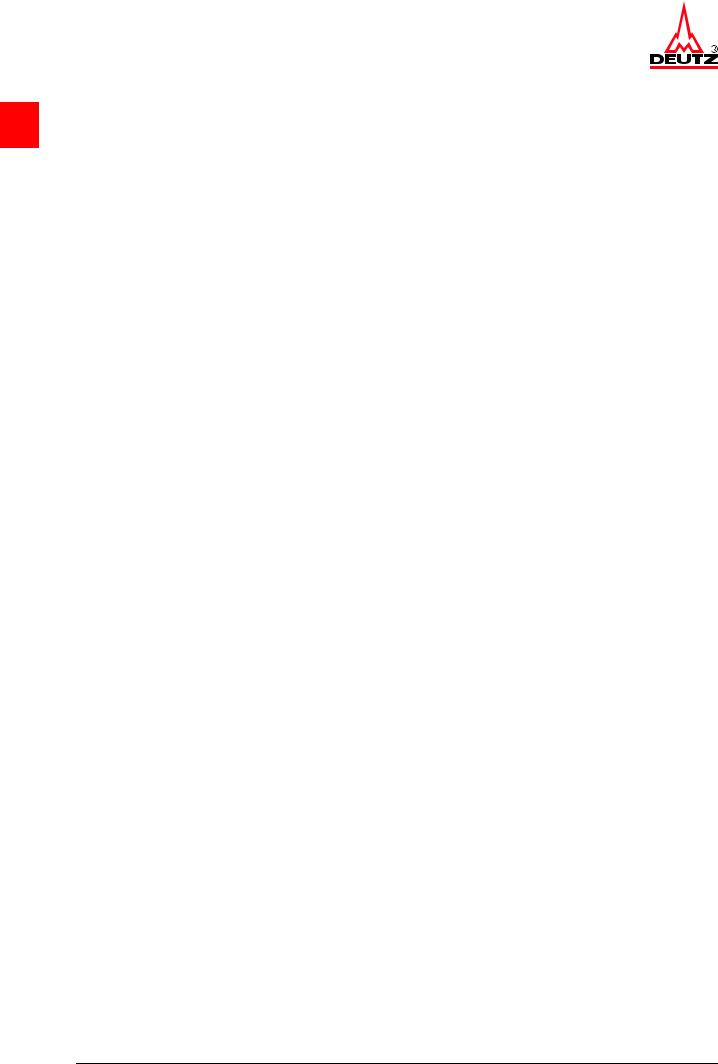
Foreword |
DEUTZ engines |
1
© 05/2005 |
4/4 |
OBJ_DOKU-21738-001.fm |
|
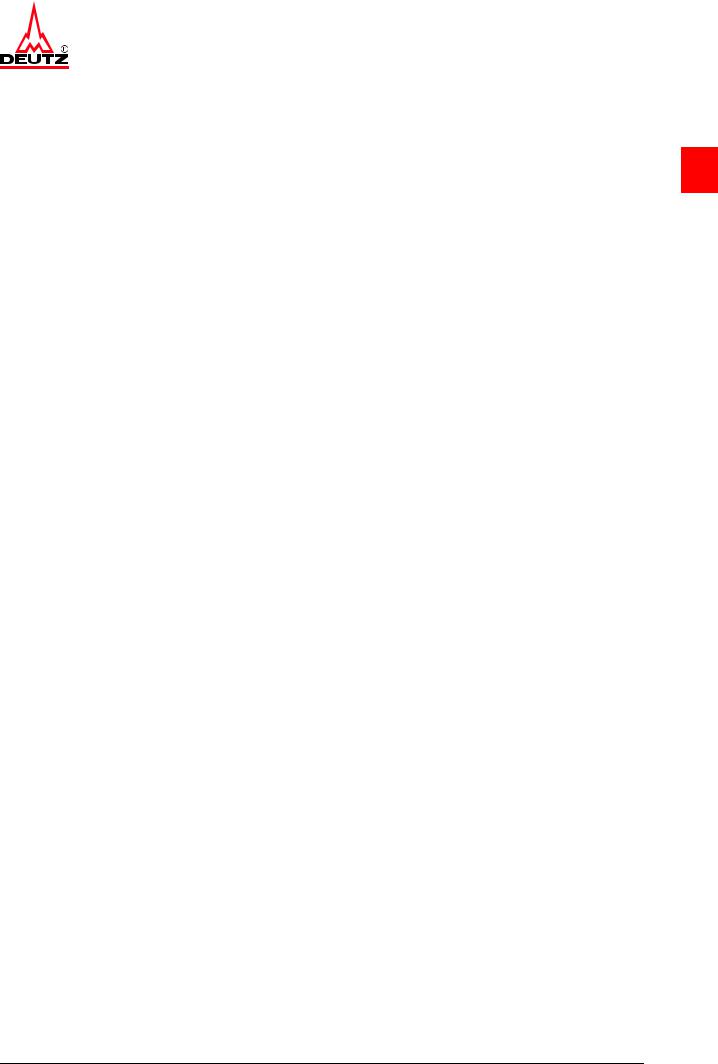
DEUTZ engines |
General |
2
2General
© 11/2005 |
1/4 |
OBJ_DOKU-21739-001.fm |
|
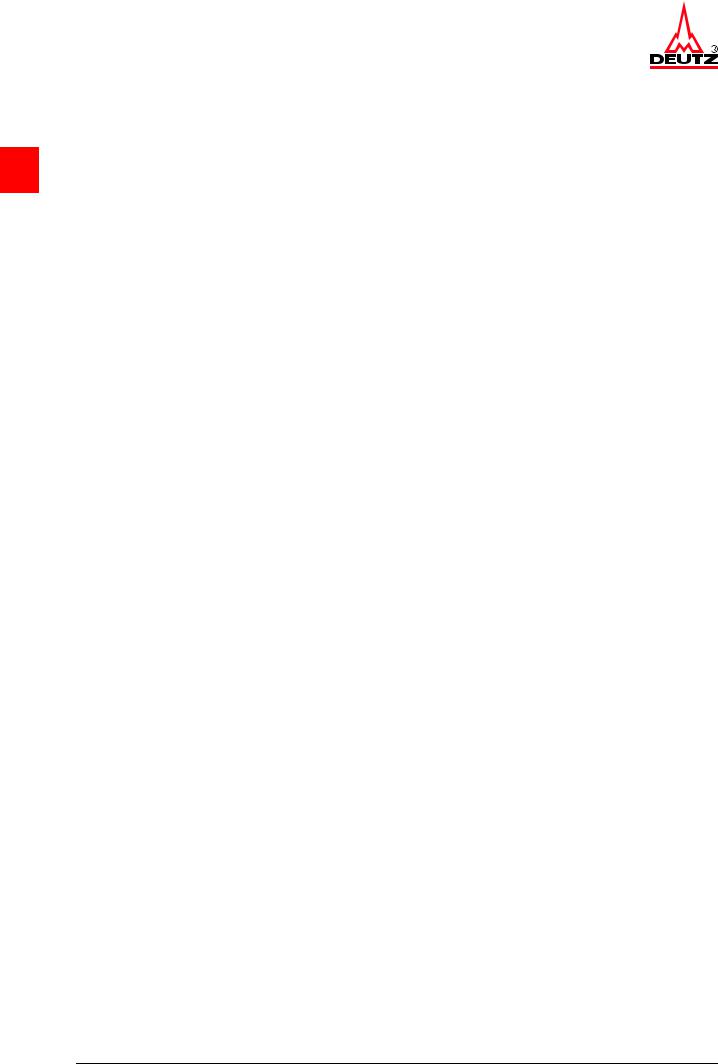
General |
DEUTZ engines |
2
© 11/2005 |
2/4 |
OBJ_DOKU-21739-001.fm |
|

DEUTZ engines |
General |
DEUTZenginesaretheproductofyearsofresearch and development. The profound expertise gained through this, in combination with high demands on quality, attests to the fact that our engines possess
all the qualities of long life, high reliability and low 2 fuel consumption. It goes without saying that the
high environmental protection requirements are also met.
Maintenance and care are the only way the engine can satisfy the demands you make on it. Compli- ancewiththeprescribedmaintenancetimesandthe carefulexecutionofmaintenanceandcareworkare therefore essential. Difficult operating conditions, deviating from normal operation, must be particular- ly heeded.
Please consult one of our service representatives responsible for operating faults and spare parts questions. Ourtrained specialist personnel ensures fast and professional repairs using original DEUTZ spare parts in the event of damage.
Original spare parts from DEUTZ AG are always manufactured according to the state of the art.
© 11/2005 |
3/4 |
OBJ_DOKU-21739-001.fm |
|

General |
DEUTZ engines |
2
© 11/2005 |
4/4 |
OBJ_DOKU-21739-001.fm |
|

DEUTZ engines |
User notes |
3
3User notes
© 02/2010 |
1/8 |
OBJ_DOKU-21740-001.fm |
|
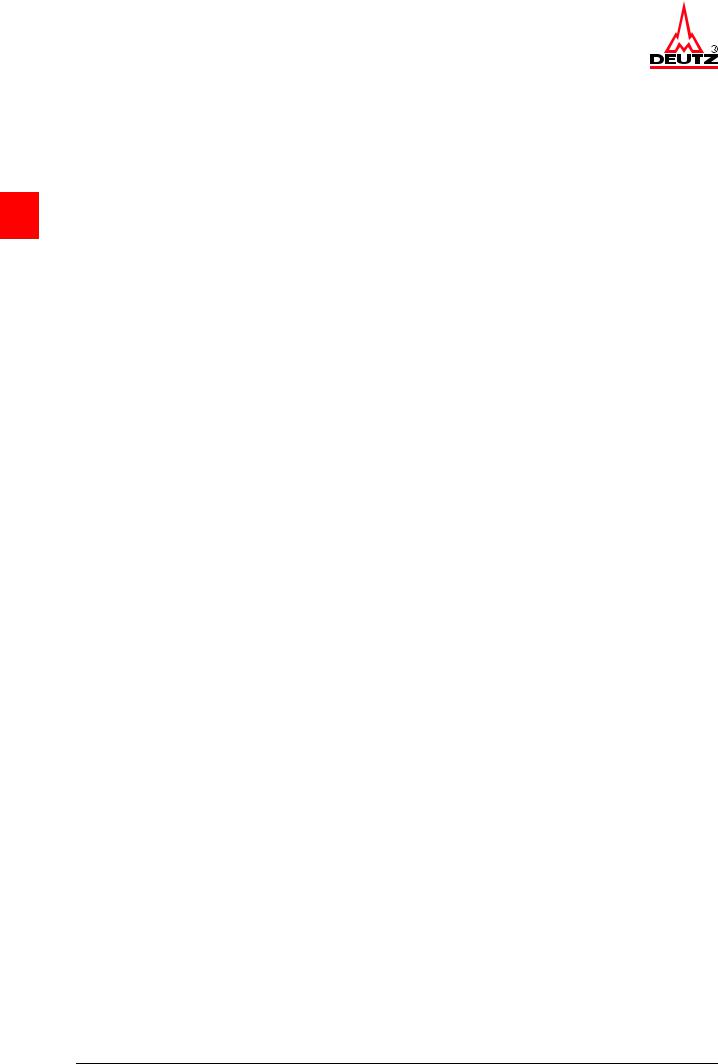
User notes |
DEUTZ engines |
3
© 02/2010 |
2/8 |
OBJ_DOKU-21740-001.fm |
|
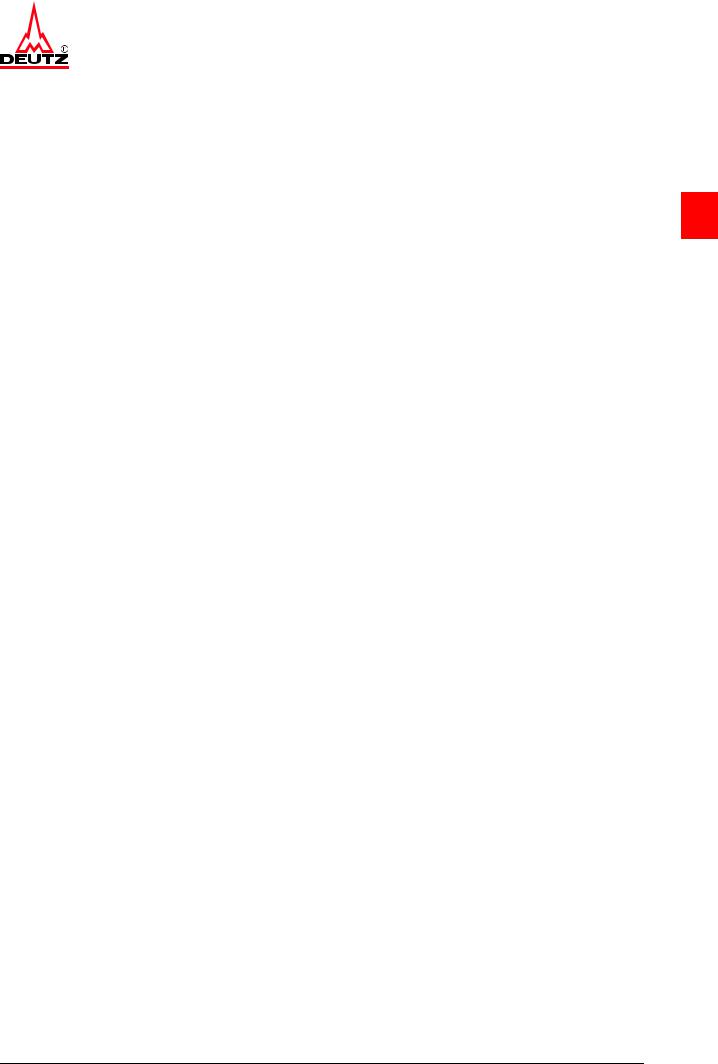
DEUTZ engines |
User notes |
3.1 General
The documentation of the workshop manual has been created based on the engine available at the time of going to press.
There may be deviations in the descriptions, illustra- tions and parts due to further developments.
The maintenance work described in the operation manualandintheworkshopmanualmustbecarried out on schedule and completely. The maintenance personnel must have the necessary technical knowledge to perform the work. Safety and protec- tiondeviceswhichareremovedduringmaintenance work must be replaced again afterwards.
Caution!
The rules for the prevention of accidents and the safety regulations must be observed during mainte- nance work.
Reference is made in the workshop manual job cards to the regulations in chapter 3.2. These must be read before working on the engine and must be strictly followed.
The maintenance intervals and the work to be per- formed are specified in the maintenance schedule of the operationmanual. The job cards contain tech- nical documentation on the execution of mainte- nance work.
3.2 Specifications
3.2.1Accident prevention and safety regula- tions
The legally prescribed rules for the prevention of ac- cidentsmustbeobserved.Theseareavailablefrom
professional associations or from dealers. These 3 are dependent on the application site, operating
mode and the operating and auxiliary materials be- ing used.
Special protection measures are specified depend- ing on the work being carried out, and are identified in the job description.
Among other things it generally applies that:
●for the personnel:
–Only briefed personnel may operate or main- tain the engine. Unauthorised persons are prohibited access to the machine room.
–Wear close-fitting clothing and ear protectors in the machine room when the engine is in op- eration.
–Only deploy trained personnel to do repairs and maintenance work.
–Do not work on the fuel system when the en- gine is running. The fuel system is under high pressure - danger of death.
–Go to the workshop immediately in case of leaks in the fuel system.
●for the engine room:
–Ensure adequate ventilation (do not cover air shafts).
–Providefirstaidkitandsuitablefireextinguish- ers. Check the filling and readiness for opera- tion regularly.
–Only store inflammable materials in the ma- chine room if they are essential for operation of the system.
–Smoking and naked flames are prohibited in the machine room.
●for operation, maintenance and repairs on the engine:
–Wait30secondsafterswitchingofftheengine before working on the fuel sytem.
–After all work on the fuel system, it must be bleeded - see the operation manual, chapter "6 Fuel system“.
–Only start the engine when all the protective deviceshavebeenfitted.Makesureno-oneis standing in the danger area.
–Cleaning, maintenance and repair work may only be performed with the engine at a stand- still and secured against starting.
–Injection lines and high pressure pipes must not be deformed.
© 02/2010 |
3/8 |
OBJ_DOKU-21740-001.fm |
|
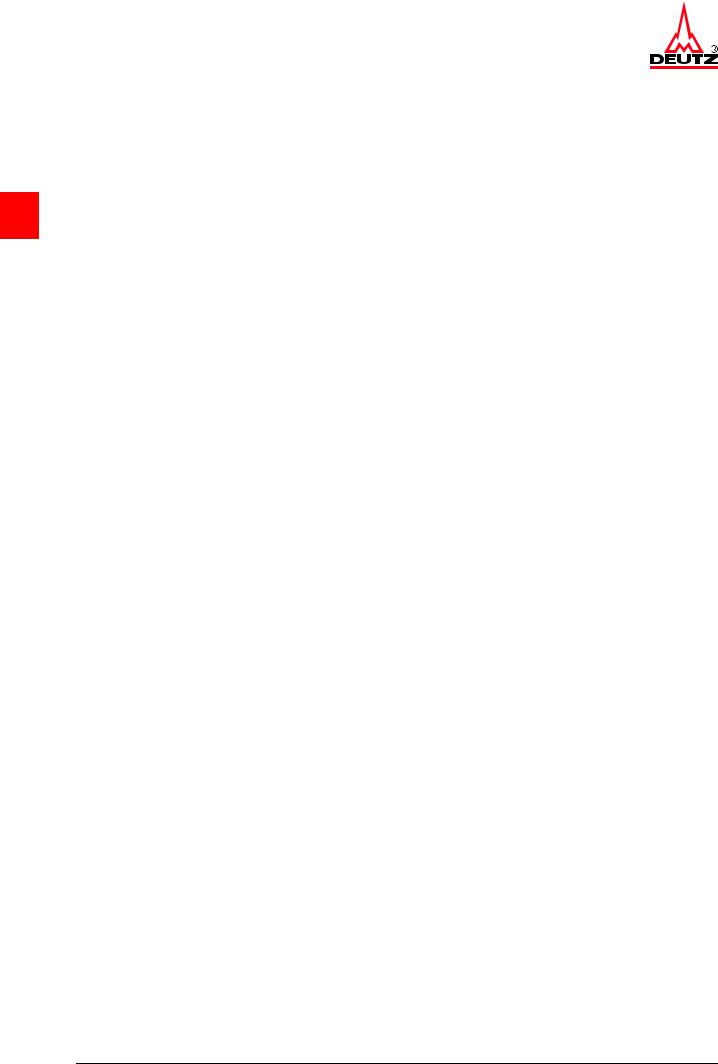
User notes |
DEUTZ engines |
–Damaged injection lines and high-pressure pipes must be renewed.
–Injection lines and high pressure fuel lines must never be connected when the engine is running.
–Do not place hands near to a leak in the high
3pressure fuel system.
–Also carefully check all high pressure compo- nents visually before performing tests on the running engine. Wear suitable protective clothing (for example protective glasses). Leaks are a potential source of danger for workshop personnel.
–Even if no leaks are discernible on the high pressurefuelsystem,theworkshoppersonnel should avoid the immediate danger zone or wear suitable protective clothing (such as pro- tective glasses) when performing tests on the running engine and during the first trial run.
–Always stay out of range of a fuel jet, as it could cause severe injury.
–Smokingisstrictlyprohibitedwhenworkingon the fuel system.
–Do not work near to sparks and flames.
–Never disconnect an injector when the engine is running.
3.2.2Cleanliness instructions and measures for handling the DEUTZ Common Rail System
The DEUTZ Common Rail system used in the DEUTZ engines consists of high-precision compo- nents which are exposed to extreme stress. Great attention must be paid to cleanliness when working on the fuel system due to the high precision technol- ogy.
Notes and measures to be observed before starting work on the fuel system
●The fuel system must be closed. Make a visual inspection for leaks / damage to the fuel system.
●Cleanthewholeengineandengineroomwiththe system closed before starting work on the fuel system.
●The engine must be dry when you start working on the fuel system.
●Blowing (dry) with compressed air is only permis- sible with the fuel system closed.
●When using a steam jet, first cover up the control unit, the cable plugs, all other electrical plug con- nections and the generator. Also, the steam jet may not be pointed directly at them.
●Electrical plug connections must be plugged when spraying.
●Remove loose parts (for example paint chips from assembly work) with an industrial vacuum cleanerorothersuctiondevice.Onlysuctionmay be used in assembly work on the open fuel sys- tem.
●Only work on the fuel system in a clean environ- ment (no dust, no grinding or welding). Avoid draughts (dust). Clean the workshop floor regu- larly.Nobrakeorperformancetest benches may be kept or operated in the same room.
●Air currents which kick up dust, such as those caused by brake repairs or the starting of en- gines, should be avoided.
●For work such as removal and installation on de- fective hydraulic components on the Common Rail System it is recommended to partition off a separateworkshopareainthefactory.Thismust be separate from other areas in which general vehicle repairs such as brake repairs are carried out.
●No general machine tools may be operated in this room.
●Regular cleaning of the workshop area is manda- tory. Draughts, ventilation systems and heating fans should be minimised.
●Areas of the engine room from which particles of dirt could be loosened (for example the bottom part of the tipped driver cab) must be covered with fresh clean film.
●Working materials and tools must be cleaned be- fore work. Only use tools without damage to the chrome plating or tools which are not chromeplated.
Notesandmeasurestobeobservedduringworkon the fuel system or with the fuel system open.
●Only work in clean overalls.
●Only lint-free cleaning cloths may be used for work on the fuel system.
●Remove loose parts (for example paint chips from assembly work) with an industrial vacuum cleanerorothersuctiondevice.Onlysuctionmay be used in assembly work on the open fuel sys- tem.
●Working materials and tools must be cleaned be- fore work. Only use tools without damage to the chrome plating or tools which are not chromeplated.
●Do not use used cleaning fluid or test fluid for cleaning.
●Compressedairmustnotbeusedforcleaningon the open fuel system.
●Work on removed components may only be per- formed at a suitably equipped workbench.
© 02/2010 |
4/8 |
OBJ_DOKU-21740-001.fm |
|

DEUTZ engines |
User notes |
●When removing and installing components, no materials which can leave behind particles or fi- bres (cardboard, wood, cloths) may be used.
●Removed parts may only be rubbed down with clean, lint-free cloths. No dirt particles may be rubbed into the components.
●Openings on the components and on the engine must be closed immediately with suitable stop- pers/caps.
●The stoppers/caps may only be removed imme- diately before installing.
●Store stoppers/caps freefrom dustanddirt in the original packaging and dispose of after using once.
●Only remove new parts from the original packag- ing just before installation.
●Removedcomponentsmustbekeptinnew,seal- ablebagsor-ifavailable-inthepackagingofthe new parts.
●Alwaysusetheoriginalpackagingofthenewpart to send back the removed components.
Notes and measures for the vehicle workshop area
●For work such as removal and installation on de- fective hydraulic components on the Common Rail System it is recommended to partition off a separateworkshopareainthefactory.Thismust be separate from other areas in which general vehicle repairs such as brake repairs are carried out.
●The workshop floor is sealed or tiled.
●No welding gear, grinders, general machine tools, brakes or performance test benches may be operated in this room.
●Regular cleaning of the workshop area is manda- tory. Draughts, ventilation systems and heating fans should be minimised.
Notes and measures for workbench and tools in the vehicle hall
●A special workbench must be set up for work on removed components.
●Cleantheremovaland installationtools regularly and keep them in a closed tool cabinet.
●Remove loose parts (for example paint chips from assembly work) with an industrial vacuum cleaner or other suction device.
●Working materials and tools must be cleaned be- fore work. Only use tools without damage to the chrome plating or tools which are not chromeplated.
3.2.3 Disposal regulations
The work described in the operation manual and workshopmanualnecessitatesrenewalofpartsand operating materials among other things. The re-
newed parts / operating materials must be stored, transported and disposed of according to regula- tions. The owner himself is responsible for this.
Disposal includes recycling and the scrapping of parts / operating materials, although recycling has priority.
Details of disposal and their monitoring are gov- |
3 |
erned by regional, national and international laws |
|
and directives which the system operator must ob- serve on his own responsibility.
© 02/2010 |
5/8 |
OBJ_DOKU-21740-001.fm |
|
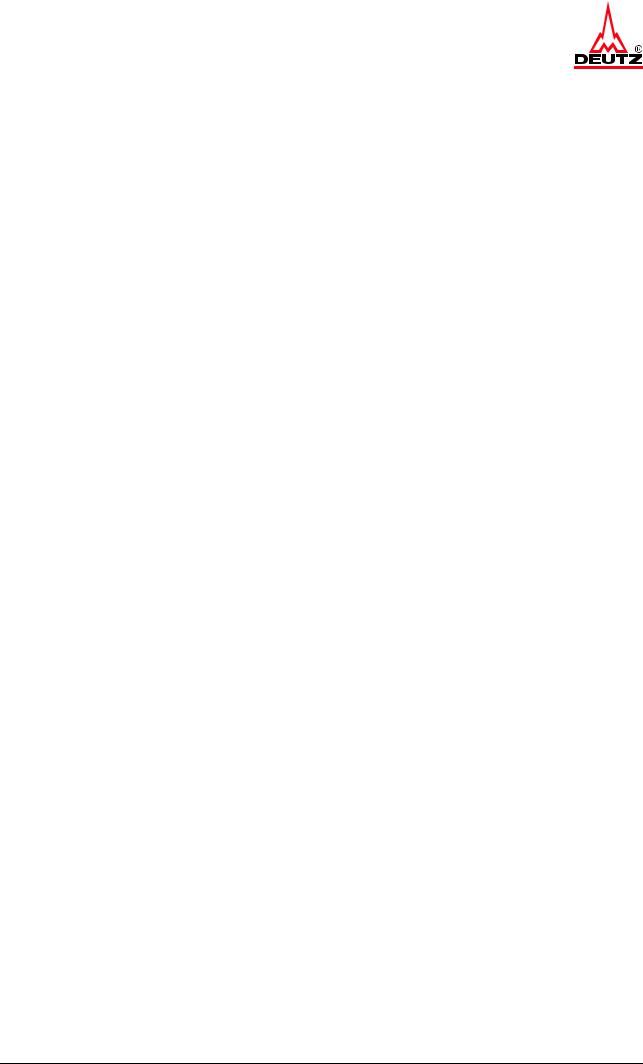
User notes |
DEUTZ engines |
3.3 Operationmanual andworkshopman-
|
|
ual |
|
To structure the information to suit the user, the |
|
|
service documentation is divided into operation |
|
|
manual and workshop manual. |
|
3 |
The operation manual contains a general descrip- |
|
tion and instructions for all other maintenance work. |
||
|
It contains the following chapters: |
|
|
||
|
1. |
Contents, General |
|
2. |
Engine description |
|
3. |
Operation |
|
4. |
Operating media |
|
5. |
Maintenance |
|
6. |
Care and maintenance work |
|
7. |
Faults, causes and remedies |
|
8. |
Engine conservation |
|
9. |
Technical data |
10.Service
The workshop manual assumes knowledge of the contents of the operation manual. This applies es- pecially for the safety regulations. The workshop manual describes repairs to the engine and compo- nents for which more effort and appropriately quali- fied technicians are required.
3.4 Job cards
The job cards are divided in the workshop manual into "W" and "I" job cards.
The"W"jobcarddocumentsstandardrepairsonthe engine and/or its components. The necessary tools and special tools are also specified in the "W" job card.
The "I" job card additionally documents the appro- priate work procedures for repairing the engine and/ or its components. The workshop must satisfy spe- cial conditions to perform these work procedures. Special tools and machine tools must be available, for example.
3.4.1 Numbering of job cards
The job card numbering uses the format W 08-03- 01. The individual parts of this format are explained below:
●W 08-03-01: Documentation type
–W....Workshop manual
–I......Repair manual
●W 08-03-01: Module according to module list
●W 08-03-01: Component group
●W 08-03-01: Consecutive number
© 02/2010 |
6/8 |
OBJ_DOKU-21740-001.fm |
|
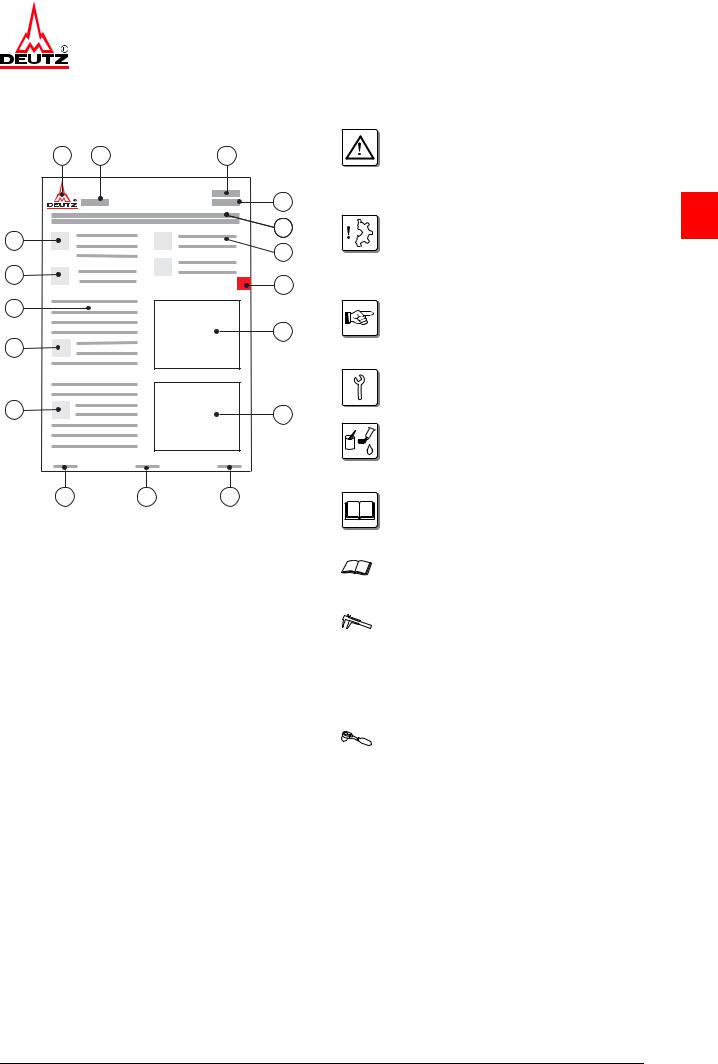
DEUTZ engines |
User notes |
3.4.2 Structure of a job card
1 |
2 |
3 |
|
|
|
|
4 |
|
|
|
5 |
16 |
|
|
|
|
|
|
6 |
15 |
|
|
|
|
|
6 |
7 |
14 |
|
|
|
|
|
|
8 |
13 |
|
|
|
12 |
|
|
8 |
|
|
|
11 |
10 |
9 |
1.DEUTZ AG,
publisher of service documentation
2.Engine type
3.Module
4.Numbering of the job cards
5.Title of job card
6.Reference to other modules with job cards
7.Chapter
8.Graphic or photo
9.DEUTZ internal creation number
10.Page number
11.Date of issue of job card 12.Note
13.Danger / Important 14.Work sequence 15.Auxiliary materials
16.Conventional tools, special tools
3.5 Explanation of symbols
Danger! |
|
of death or to health. Must be observed! |
|
For example: The incorrect use or conver- |
|
sionoftheturbochargercanleadtoserious |
|
injury. |
3 |
Caution! |
Danger to the component/engine. Noncompliance can lead to destruction of the component/engine.
Must be observed!
Note
Generalnotesonassembly,environmental protectionetc. Nopotentialdanger forman or machine.
Tool
Conventionalandspecialtoolsrequiredfor the work.
Auxiliary materials
Working materials required in addition to the tools for performing the work
(e.g. greases, oils, adhesives, sealants)
References
toimportantdocumentsorjobcardsforthe work process.
For example: Job card W 04-05-05
Reference
to a document or a job card within the work process.
Test and setting data
The necessary values are specified here. If several values are necessary, a cross reference is given to the Test and Setting Values table.
For example:
ID no. P01 61 = valve clearance, inlet
Tightening specification
The necessary values are specified here. If several values are necessary, a cross reference is given to the Tightening Specifications table.
For example:
ID no. A01 001 = cylinder head screws
© 02/2010 |
7/8 |
OBJ_DOKU-21740-001.fm |
|

User notes |
DEUTZ engines |
3
© 02/2010 |
8/8 |
OBJ_DOKU-21740-001.fm |
|
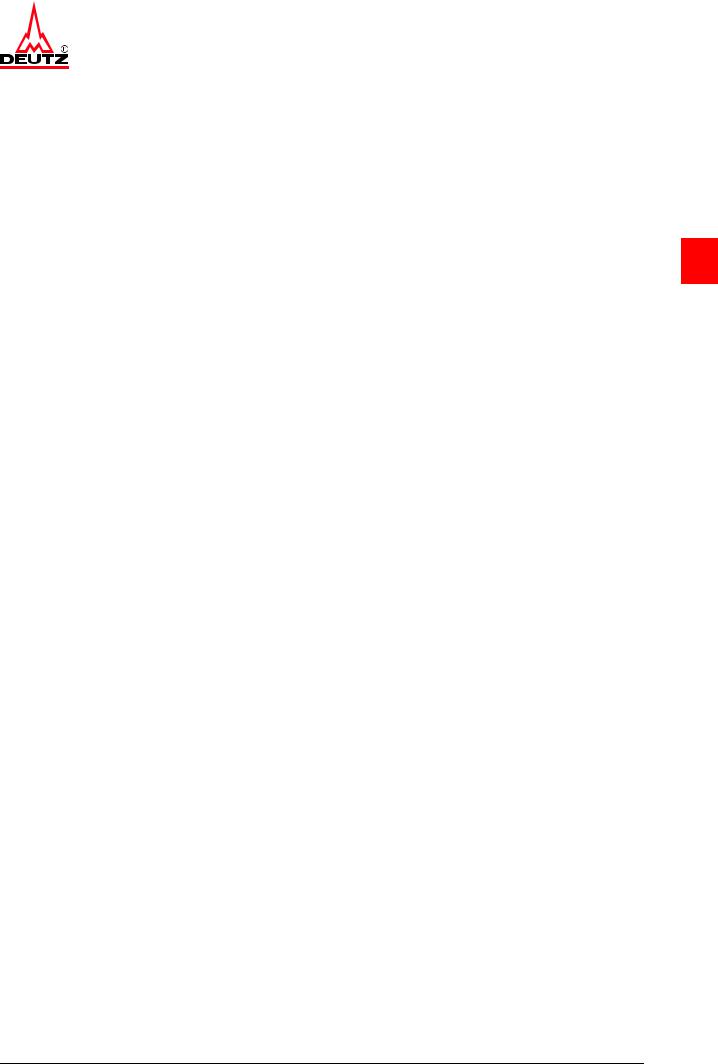
|
Technical data |
TCD 2013 2V |
Testing and setting data |
4
4Technical data
4.1Testing and setting data
© 02/2010 |
1/18 |
OBJ_DOKU-21741-001.fm |
|

Technical data |
|
Testing and setting data |
TCD 2013 2V |
4
© 02/2010 |
2/18 |
OBJ_DOKU-21741-001.fm |
|

02/2010 ©
3/18
fm.001-21741-DOKU_OBJ
ID no. |
Name |
Information |
Series |
|
|
Value |
Unit |
General engine data |
|
|
|
|
|
|
|
P00 71 |
Ignition sequence |
|
TCD 2013 |
L4 |
2V |
1-3-4-2 |
- |
|
|
|
|
||||
|
L6 |
2V |
1-5-3-6-2-4 |
||||
|
|
|
|
|
|
|
|
Valve guide |
|
|
|
|
|
|
|
|
|
|
|
|
|
|
|
Valve |
|
|
|
|
|
|
|
P01 31 |
Valve shaft diameter, inlet |
Standard, fit h7 |
TCD 2013 |
|
2V |
8,98-00,05 |
mm |
|
|
|
|
|
|
|
|
P01 32 |
Valve shaft diameter, outlet |
Standard, fit h7 |
TCD 2013 |
|
2V |
8,96-00,05 |
mm |
|
|
|
|
|
|
|
|
P01 33 |
Valve stem clearance, inlet |
|
TCD 2013 |
|
2V |
0,045 - 0,075 |
mm |
|
|
|
|
|
|
|
|
P01 34 |
Valve stem clearance, outlet |
|
TCD 2013 |
|
2V |
0,065 - 0,095 |
mm |
|
|
|
|
|
|
|
|
P01 35 |
Valve edge thickness, inlet |
|
TCD 2013 |
|
2V |
2,62 |
mm |
|
|
|
|
|
|
|
|
P01 36 |
Valve edge thickness, outlet |
|
TCD 2013 |
|
2V |
2,3 |
mm |
|
|
|
|
|
|
|
|
P01 37 |
Valve head diameter, inlet |
|
TCD 2013 |
|
2V |
48-+0,10,1 |
mm |
P01 38 |
Valve head diameter, outlet |
|
TCD 2013 |
|
2V |
42-+0,10,1 |
mm |
Valve seat |
|
|
|
|
|
|
|
P01 45 |
Valve lag dimension, inlet |
|
TCD 2013 |
|
2V |
0,99-+0,10,1 |
mm |
P01 46 |
Valve lag dimension, outlet |
|
TCD 2013 |
|
2V |
1-+0,10,15 |
mm |
Valve spring |
|
|
|
|
|
|
|
P01 51 |
Valve spring length |
untensioned, normal |
TCD 2013 |
|
2V |
64,7 |
mm |
|
|
|
|
|
|||
Valve spring wire diameter |
|
|
4,5 |
mm |
|||
|
|
|
|
|
|
|
|
Valve clearance |
|
|
|
|
|
|
|
P01 61 |
Valve clearance, inlet (on cold engine) |
Oil temperature < 80 °C, |
TCD 2013 |
|
2V |
90 |
° |
after a cooling time of at least 0.5 h |
|
||||||
|
|
|
|
|
|
|
|
P01 62 |
Valve clearance, outlet (on cold engine) |
Oil temperature < 80 °C, |
TCD 2013 |
|
2V |
150 |
° |
after a cooling time of at least 0.5 h |
|
||||||
|
|
|
|
|
|
|
|
|
|
|
|
|
|
|
|
2V 2013 TCD
data Technical
data setting and Testing
4

|
|
|
|
|
|
|
|
|
4 |
|
|
© |
|
|
|
|
|
|
|
|
|
|
|
|
|
|
|
|
|
|
|
|
|
|
|
|
ID no. |
Name |
Information |
Series |
|
|
Value |
Unit |
|||
02/2010 |
|
|
|
||||||||
|
P01 63 |
Valve clearance setting |
Valve overlap according to setting |
TCD 2013 |
|
2V |
- |
|
|
|
|
|
|
|
|
|
|
||||||
|
|
schematic see: Table T01 63 |
|
|
|
|
|||||
|
|
|
|
|
|
|
|
|
|
|
|
|
|
|
|
|
|
|
|
|
|
|
|
|
|
P01 64 |
Clearancebetweencontrolpistonandrockerarm |
Oil temperature < 80 °C, |
TCD 2013 |
|
2V |
144 |
|
° |
|
|
|
after a cooling time of at least 0.5 h |
|
|
|||||||
|
|
Rocker arm/bracket |
|
|
|
|
|
|
|
|
|
|
|
P01 72 |
Rocker arm, bore, diameter, outlet |
|
TCD 2013 |
|
2V |
21,020+0,033 |
mm |
||
|
|
P01 73 |
Rocker arm, bore, diameter, inlet |
|
TCD 2013 |
|
2V |
21,020+0,033 |
mm |
||
|
|
P01 74 |
Rocker arm journal |
Diameter, fit h7 |
TCD 2013 |
|
2V |
21-00,021 |
|
mm |
|
|
|
|
|
|
|
|
|
|
|
|
|
|
|
Main bearing pin |
|
|
|
|
|
|
|
|
|
|
|
P02 03 |
Main bearing pin |
Standard, diameter |
TCD 2013 |
|
2V |
85,00-00,02 |
mm |
||
|
|
|
|
|
|
|
|
|
|
|
|
|
|
P02 04 |
Crankshaft main bearing pin |
Underdimension stage |
TCD 2013 |
|
2V |
0,25 |
|
mm |
|
|
|
|
|
|
|
|
|
|
|
||
4/18 |
|
P02 05 |
Limit for undermeasure step |
|
TCD 2013 |
|
2V |
84,50-00,02 |
mm |
||
|
|
|
|
|
|
|
|
|
|
||
|
P02 06 |
Pin unroundness |
Wear limit |
TCD 2013 |
|
2V |
0,01 |
|
mm |
||
|
|
|
|
|
|
|
|
|
|
|
|
|
|
P02 07 |
Crankshaft main bearing pin and lifting journal, |
|
|
|
|
+3 |
|
|
|
|
|
hardness |
Standard HRC |
TCD 2013 |
|
2V |
53-3 |
|
HRC |
||
|
|
|
|
|
|
|
|
|
|
|
|
|
|
Fit bearing pin |
|
|
|
|
|
|
|
|
|
|
|
P02 11 |
Fit bearing pin, width |
|
TCD 2013 |
|
2V |
38+0,06 |
|
|
|
|
|
P02 12 |
Fit bearing pin, width |
one overmeasure stage |
TCD 2013 |
|
2V |
0,4 |
|
mm |
|
|
|
|
|
|
|
|
|
|
|
|
|
|
|
P02 13 |
Limit for overmeasure step |
|
TCD 2013 |
|
2V |
38,46 |
|
mm |
|
|
|
|
|
|
|
|
|
|
|
|
|
|
|
Lifting journal |
|
|
|
|
|
|
|
|
|
|
|
P02 22 |
Lifting journal, diameter |
|
TCD 2013 |
|
2V |
68,00-00,02 |
mm |
||
|
|
|
|
|
|
|
|
|
|
|
|
OBJ |
|
P02 23 |
Lifting journal, diameter |
Undermeasure per stage |
TCD 2013 |
|
2V |
0,25 |
|
mm |
|
|
|
|
|
|
|
|
|
|
|||
|
P02 24 |
Limit for undermeasure step |
|
TCD 20113 |
|
2V |
67,50-00,02 |
mm |
|||
.001-21741DOKU- |
|
|
|
|
|
|
|
|
|
|
|
|
P02 25 |
Pin unroundness |
Wear limit |
TCD 2013 |
|
2V |
0,01 |
|
mm |
||
|
|
|
|
||||||||
fm |
|
|
|
|
|
|
|
|
|
|
|
|
|
|
|
|
|
|
|
|
|
|
|
data Technical
data setting and Testing
2V 2013 TCD
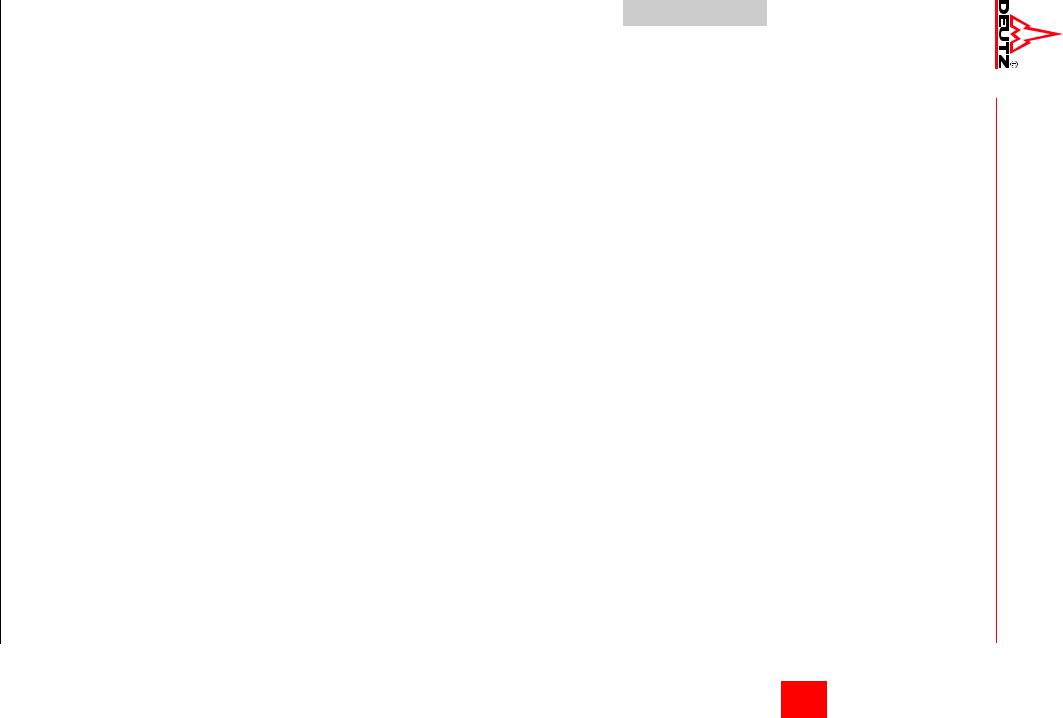
02/2010 ©
5/18
fm.001-21741-DOKU_OBJ
ID no. |
Name |
Information |
Series |
|
|
Value |
Unit |
P02 26 |
Radial run-out, crankshaft |
maximum permissible deviation |
TCD 2013 |
L4 |
2V |
0,07 |
mm |
|
|
|
|
||||
L6 |
|
0,10 |
mm |
||||
|
|
|
|
|
|
|
|
Main bearing |
|
|
|
|
|
|
|
P02 34 |
Permissible axial clearance of crankshaft |
in installed state |
TCD 2013 |
|
2V |
0,1 - 0,3 |
mm |
|
|
|
|
|
|
|
|
P02 35 |
Thrust ring, thickness |
Standard (upper and lower half) |
TCD 2013 |
|
2V |
2,90+0,05 |
mm |
P02 36 |
Thrust ring, oversize |
1. Step = 0.2 mm |
TCD 2013 |
|
2V |
3,10+0,05 |
mm |
Con-rod |
|
|
|
|
|
|
|
P02 41 |
Parallelism of the con rod with respect to the pis- |
permissible deviation |
TCD 2013 |
|
2V |
0,05 |
mm |
ton bolt |
at a distance of 100 mm |
|
|||||
|
|
|
|
|
|
|
|
P02 42 |
Parallelism of the con rod with respect to the pis- |
permissible deviation |
TCD 2013 |
|
2V |
0,05 |
mm |
ton bolt |
at a distance of 100 mm |
|
|||||
|
|
|
|
|
|
|
|
P02 43 |
Piston bolt liner, inside diameter |
installed, unmachined |
TCD 2013 |
|
2V |
42++0,040,05 |
mm |
P02 45 |
Small end bush clearance between piston pin |
|
TCD 2013 |
|
2V |
0,034 - 0,056 |
mm |
and small end bush |
|
|
|||||
Big end bearing |
|
|
|
|
|
|
|
P02 52 |
Big end bearing shells, inside diameter |
installed |
TCD 2013 |
|
2V |
72,50+0,02 |
mm |
P02 55 |
Big end bearing, bore in con rod |
H6 |
TCD 2013 |
|
2V |
72,5 |
mm |
|
|
|
|
|
|
|
|
P02 56 |
Theoretical clearance between the big end |
|
TCD 2013 |
|
2V |
0,036 - 0,095 |
mm |
bearing / lifting journal |
|
|
|||||
Piston bolt |
|
|
|
|
|
|
|
P02 61 |
Piston pin, diameter |
|
TCD 2013 |
|
2V |
42-0,006 |
mm |
|
|
|
|
|
|
|
|
Piston |
|
|
|
|
|
|
|
P02 70 |
Piston |
Identification of the installation position on the piston base |
|
|
|
||
|
|
|
|
|
|
|
|
P02 71 |
Piston, diameter, standard |
Measuring point 1 = height 12 mm |
TCD 2013 |
|
2V |
107,700 |
mm |
|
|
|
|
|
|
|
|
P02 72 |
Piston, diameter, standard |
Measuring point 2 = height 64 mm |
TCD 2013 |
|
2V |
107,800 |
mm |
|
|
|
|
|
|
|
|
2V 2013 TCD
data Technical
data setting and Testing
4
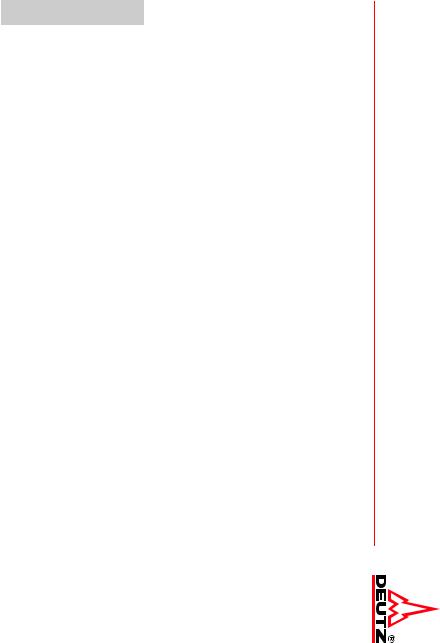
|
|
|
|
|
|
|
|
|
4 |
|
|
|
© |
|
|
|
|
|
|
|
|
|
|
|
|
|
|
|
|
|
|
|
|
|
|
|
|
|
|
ID no. |
Name |
Information |
Series |
|
|
Value |
Unit |
||||
02/2010 |
|
|
|
|||||||||
|
P02 73 |
Piston, diameter, standard |
Measuring point 3 = height 97 mm |
TCD 2013 |
|
2V |
107,660 |
|
mm |
|||
|
|
|
|
|||||||||
|
|
|
|
|
|
|
|
|
|
|||
|
|
P02 75 |
Piston protrusion |
1 hole, cylinder head gasket, 1.42 mm |
TCD 2013 |
|
2V |
0,28 - < 0,54 |
mm |
|||
|
|
|
|
|
|
|
|
|
|
|||
|
|
P02 76 |
Piston protrusion |
2 hole, cylinder head gasket, 1.52 mm |
TCD 2013 |
|
2V |
0,54 - < 0,64 |
mm |
|||
|
|
|
|
|
|
|
|
|
|
|||
|
|
P02 77 |
Piston protrusion |
3 hole, cylinder head gasket, 1.62 mm |
TCD 2013 |
|
2V |
0,64 - 0,75 |
mm |
|||
|
|
|
|
|
|
|
|
|
|
|
||
|
|
P02 78 |
Piston bolt, bore |
|
TCD 2013 |
|
2V |
42++0,010,017 |
|
mm |
||
|
|
Piston rings |
|
|
|
|
|
|
|
|
|
|
|
|
P02 84 |
Joint clearance, piston ring 1 |
Identification (TOP) in direction of |
TCD 2013 |
|
2V |
0,3 - 0,55 |
mm |
|||
|
|
combustion chamber |
|
|||||||||
|
|
|
|
|
|
|
|
|
|
|
|
|
|
|
P02 85 |
Joint clearance, piston ring 2 |
Identification (TOP) in direction of |
TCD 2013 |
|
2V |
1,5 - 2,0 |
|
mm |
||
|
|
combustion chamber |
|
|
||||||||
|
|
|
|
|
|
|
|
|
|
|
|
|
|
|
|
|
|
|
|
|
|
|
|
|
|
|
|
P02 86 |
Joint clearance, piston ring 3 |
Identification (TOP) in direction of |
TCD 2013 |
|
2V |
0,3 - 0,6 |
|
mm |
||
|
|
combustion chamber |
|
|
||||||||
6/18 |
|
|
|
|
|
|
|
|
|
|
|
|
|
|
|
|
|
|
|
|
|
||||
|
P02 87 |
Axial clearance, 1st ring (double-sided keystone |
|
|
|
|
Measure with trapezo- |
|
||||
|
|
ring) |
Wear limit |
TCD 2013 |
|
2V |
idal groove wear |
- |
||||
|
|
|
|
|
|
|
|
gauge |
|
|||
|
|
P02 88 |
Axial clearance, 2nd ring (taper-faced ring) |
|
TCD 2013 |
|
2V |
0,09 - 0,13 |
mm |
|||
|
|
|
|
|
|
|
|
|
|
|
|
|
|
|
P02 89 |
Axial clearance, 3rd ring , (bevelland-edge oil |
|
TCD 2013 |
|
2V |
0,03 - 0,075 |
mm |
|||
|
|
control ring) |
|
|
||||||||
|
|
|
|
|
|
|
|
|
|
|
|
|
|
|
Crankcase |
|
|
|
|
|
|
|
|
|
|
|
|
Cylinder liners |
|
|
|
|
|
|
|
|
|
|
|
|
|
|
|
|
|
|
|
|
|
||
|
|
P03 31 |
Cylinder bore, inside diameter |
Standard |
TCD 2013 |
|
2V |
108+0,02 |
|
mm |
||
|
|
P03 35 |
Fit depth of collar rest and sealing surface for cy- |
|
TCD 2013 |
|
2V |
8,92 |
+0,03 |
|
mm |
|
|
|
linder liner |
|
|
|
|
||||||
OBJ |
|
P03 36 |
Cylinder liners, collar height |
|
TCD 2013 |
|
2V |
9-0,02 |
|
mm |
||
_ |
|
|
|
|
|
|
|
|
|
|
|
|
.001-21741-DOKU |
|
P03 39 |
Cylinder liner, overhang |
|
TCD 2013 |
|
2V |
max. 0.080 |
mm |
|||
|
|
|
|
at least 0.030 |
mm |
|||||||
|
|
|
|
|
|
|
|
|||||
fm |
|
|
|
|
|
|
|
|
|
|
|
|
|
|
|
|
|
|
|
|
|
|
|
|
|
data Technical
data setting and Testing
2V 2013 TCD
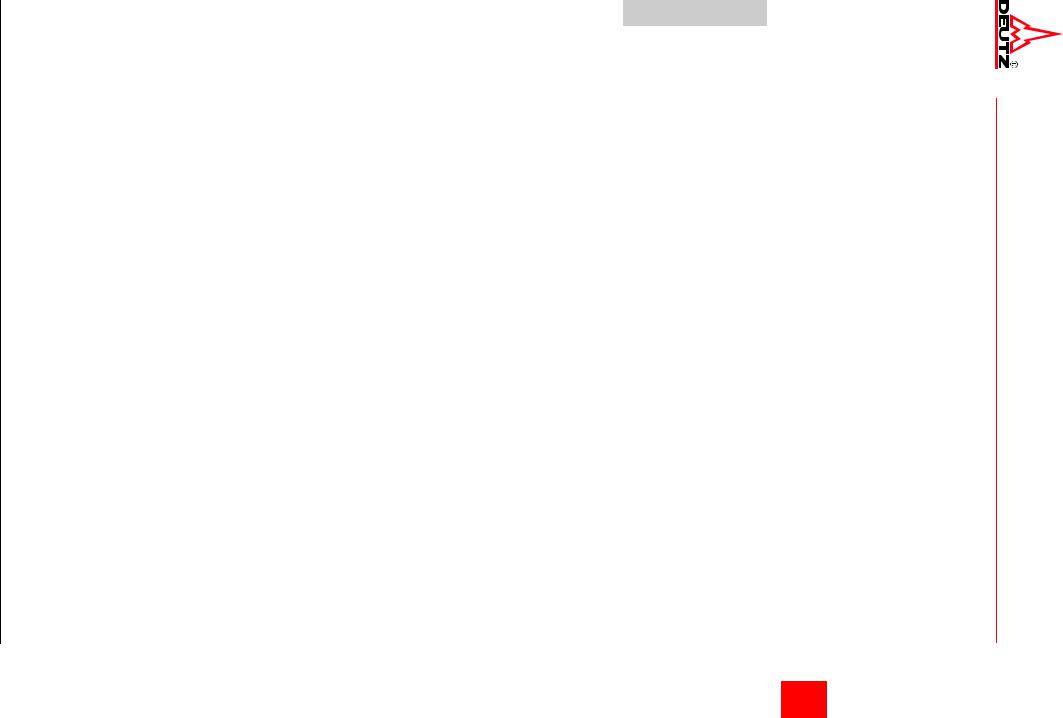
02/2010 ©
7/18
fm.001-21741-DOKU_OBJ
ID no. |
Name |
Information |
Series |
|
|
Value |
Unit |
Engine control |
|
|
|
|
|
|
|
Camshaft |
|
|
|
|
|
|
|
|
|
|
|
|
|
|
|
P04 31 |
Camshaft bearing pin diameter |
Standard |
TCD 2013 |
|
2V |
64,2-+0,20,2 |
mm |
P05 91 |
Gap dimension speed governor (crankshaft) |
|
TCD 2013 |
|
2V |
0,6-+0,10,1 |
mm |
Lubricating oil system |
|
|
|
|
|
|
|
P08 44 |
Lengthofcompressionspringfortheoilpressure |
|
TCD 2013 |
|
2V |
62 |
mm |
control valve |
|
|
|||||
|
|
|
|
|
|
|
|
Cooling system |
|
|
|
|
|
|
|
P09 11 |
Coolant thermostat start of opening |
|
TCD 2013 |
|
2V |
83 |
mm |
|
|
|
|
|
|
|
|
P09 13 |
Coolant thermostat stroke |
|
TCD 2013 |
|
2V |
at least 8 |
mm |
|
|
|
|
|
|
|
|
Other components |
|
|
|
|
|
|
|
P12 11 |
Tension of the V-belt (generator/coolant pump) |
First assembly |
TCD 2013 |
|
2V |
650 |
N |
|
|
|
|
|
|
|
|
P12 21 |
Tension of the V-belt (generator/coolant pump) |
Check after 15 minutes running under |
|
|
|
+50 |
|
load |
TCD 2013 |
|
2V |
400-50 |
N |
||
|
|
|
|
|
|
|
|
2V 2013 TCD
data Technical
data setting and Testing
4
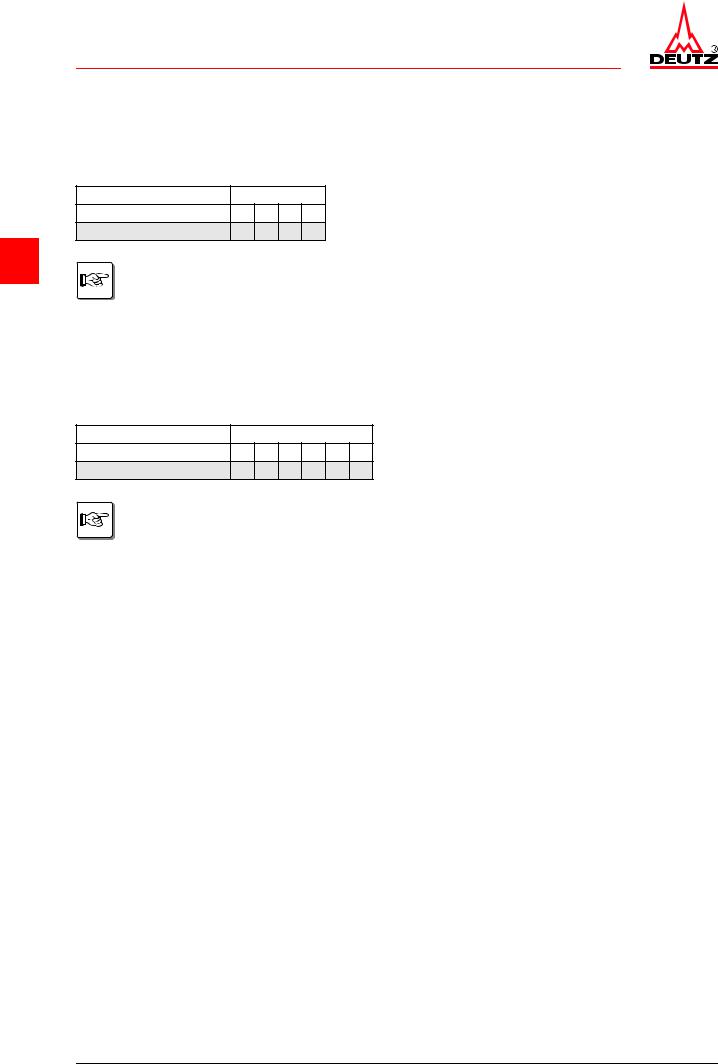
Technical data |
|
Testing and setting data |
TCD 2013 2V |
T01 63
Setting of valve and control piston clearance 4-cylinder
ignition sequence: 1 - 3 - 4 - 2
Valves |
|
Cylinder |
|
|
overlap |
1 |
3 |
4 |
2 |
Set to |
4 |
2 |
1 |
3 |
4Valve overlap: Outlet valve is not yet
closed, inlet valve begins opening.
The inlet valve opens briefly by 2 mm when the oulet valve is fully open. This is not the valve overlap!
T01 63
Setting valve and control piston clearance 6-cylinder
ignition sequence: 1 - 5 - 3 - 6 - 2 - 4
Valves |
|
|
Cylinder |
|
|
|
overlap |
1 |
5 |
3 |
6 |
2 |
4 |
Set to |
6 |
2 |
4 |
1 |
5 |
3 |
Valve overlap: Outlet valve is not yet closed, inlet valve begins to open.
When the inlet valve is fully open, the out- let valve opens briefly by about 2 mm. This is not the valve overlap!
© 00000-0
© 00000-0
© 02/2010 |
8/18 |
OBJ_DOKU-21741-001.fm |
|

|
Technical data |
TCD 2013 2V |
Tightening specifications |
4
4.2Tightening specifications
© 02/2010 |
9/18 |
OBJ_DOKU-21741-001.fm |
|
